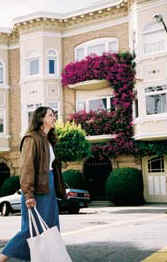
Dr. John Holtzclaw
Laura had recently moved to the city, and was distressed at the carbon emissions she and her neighbors must be emitting. She knew they were adding to climate disruption and was curious about how and how much they could lower their emissions. She tried googling.
The more she dug, the more concerned she became about how much electricity and heating she used, and where it came from, how it was generated (but that’s another blog). She found that driving was a huge carbon emitter.
Complete Communities
She compared her electrical and gas use with her parents in a nearby suburb. She and her two roommates were using only ¼ as much. Why? They shared walls with neighbors on either side and above and below, exposing much less surface to the sun, winds and rain. And they didn’t need nearly as much space per person because they had nearby friends, parks and great places to gather, and a wealth of cafes, 500 restaurants within a mile, and entertainment. Nor did they need a garage, nor room for yard maintenance equipment. All this amounted to much less space to heat or cool. Or lawn to water.
Having less lawn, their digs used less fertilizer (made from natural gas). Their neighborhood convenience took less driving for pizza, and has far less roadway to build and maintain.
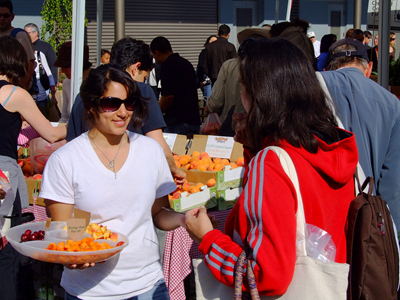
Laura loved her neighborhood’s great nearby markets, including a farmers market. And also the restored historic district, and music halls and museums. The views from the high rises make for favorite weekend visits. She chuckled to herself when she ditched her car at her parents house.
Her corner grocer, Mohammed, came from Iraq. She had never met a Muslim before. But he had a great sense of humor, and took responsibility for the nearby streets as well as his market, giving an extra sense of safety – Jane Jacobs’ “eyes on the street.” Knowing him in person liberated her from the 2-D stereotype cast by TV “news.”
She explored Hispanic, Asian and African markets. And the neighborhood had poor as well as some wealthy folk. She relishsed living in a real community, with a sense of shared interests and variety of opinions. A very rich mix.
Her favorite grandmother (not that Laura would play favorites) was planning to move into the city to avoid having to drive every trip, and liberating her from auto costs and the hazards of driving.
Public Transit
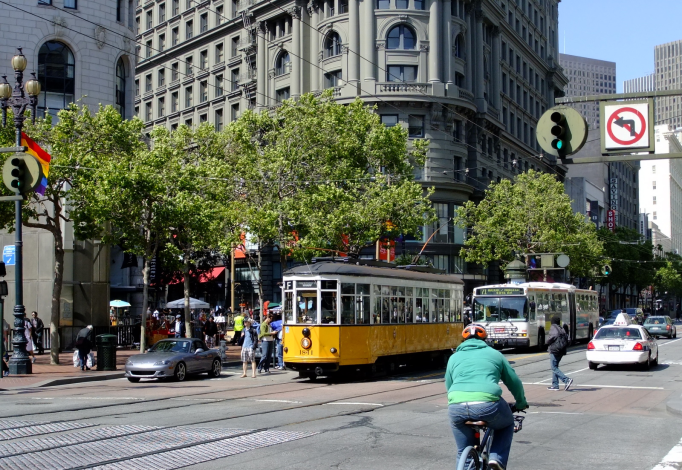
Speaking of choices of public transit for those longer trips (we weren’t but we will now), Laura could choose between buses and trolley (electric) buses, historic streetcars and modern light rail, as well as subways. With her girlfriend Gupta’s help, she quickly discovered that each filled a niche, and made her life easier.
She also learned from googling that moving passengers from cars and planes to rail, especially high speed rail, and moving freight from trucks to rail saved energy and emissions, and electrifying the rail greatly reduced them even farther
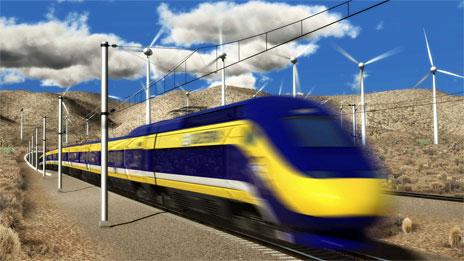
California High Speed Rail Authority image
Complete Streets
She did notice that the city was tearing up pavement on many major streets and widening the sidewalks, and extending them across parking lanes at corners. And putting bike lanes next to the sidewalks, protected from traffic by a row of parked cars. Her friend Kai Tsai called it complete streets. It really seemed to calm traffic. Even her wussiest roommate tried biking to work. Perhaps even her grandmother would give cycling a try.
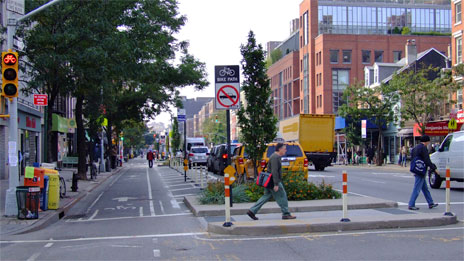
The other side of this coin is to avoid building roads that require so much driving and induce additional traffic. Build or widen a freeway and you make farther destinations more attractive, inducing changes in trip destinations and home moves requiring longer commutes. This induced traffic increases climate disruption and other pollution emissions, fuel use and costs, and road wear and maintenance costs.
Bikeshare, Carshare
Rodrigo told her about a new game in town, or actually about to be unveiled – bikeshare. It was the latest rage; every city wanted one to prove they were a 21st Century city. Bikes would be clustered in convenient stations near transit, markets, employment and residential centers, museums. You could then take one using your membership card and leave it at this or any other bikeshare station. Membership would be $100/year or less and the first half or three quarter hour on the bike would be free, with modest charges above that. Membership cards quickly become status symbols! And all these walking and cycling improvements really reduced traffic, parking requirements and the city’s maintenance costs.
Array
Laura knew the city already had carshare, which worked similarly to bikeshare, but for cars. You joined and had your choice of minicars, sedans, sports cars and pickups. It induced many members to ditch owning a car since they had one when needed. Having to pay for the time you have the car proves an incentive to walk, cycle or transit rather than driving.
Retrofitting Suburbs
Laura thought about why suburbs like the one she grew up in required driving for every loaf of bread, and puzzled about how to repair them. She googled and found that sprawl was not accidental, but driven by federal policy. Commerce Secretary Herbert Hoover promoted model zoning laws that included large-setback single-family housing, off-street parking and wide streets, while prohibiting markets and some sidewalks. Federally funded freeway construction bulldozed central city housing and commerce, destroying and dividing neighborhoods, bringing in hazardous traffic, noise, and pollution, and connecting central city jobs to sprawl development on cheap farmland and natural areas, while loading infrastructure costs onto the rest of the community. That explained why almost everything you wanted to get to required driving. And it is very expensive to provide public transit where the trip lengths are so long and passengers so few, and the public reluctant to fund “empty buses.”